Biophysical quanti fication of biodiversity and ecosystems services of forest ecosystems in the Western Ghats:a case study of Uttara Kannada District,India
Priya P.Joshi?Indu K.Murthy,2?Gurunath T.Hegde?Vani Sathyanarayan?Savithri Bhat?Vishal Patil?Tashina Esteves?N.H.Ravindranath
Introduction
Forests account for a third of the earth’s land area and about 80%of its terrestrial biodiversity.Globally,the livelihood of close to 1.6 billion people is dependent on forests(MoEFCC,GIZ 2014).Forests provide multiple supporting,provisioning,regulating and cultural services to human well-being.According to studies reviewed by TEEB (2010),the contribution of forests and other ecosystems to the livelihoods and incomes of the poor rural households is signi ficant.The importance of the forest sector to national GDP is signi ficant in many tropical countries.The state and health of forests,in particular the tropical forests,is crucial for the economy and livelihood of vast populations in tropical countries,the poor in particular(FAO 2014;Delgado et al.2013).The greatest gains in well-being of the poor occur through more equitable and secure access to provisioning ecosystem services(Dhyani and Dhyani 2016).
India is one of the mega-biodiverse countries in the world and around 1.2 billion people co-exist with 7–8%of all recorded species,including over 45,000 species of plants and 91,000 species of animals,of which several are keystone species(TEEB 2010).Biodiversity–diversity within and among species,relates to the production of most ecosystem services(Patricia et al.2006;Hooper et al.2005).Managing ecosystems for only a limited set of goods and services,such as timber or non-timber forest products(NTFPs)(Nasi and Frost 2009),may result in over shadowing many other ecosystem services and cause them to be undervalued.Foreffective managementand conservation of ecosystems,decision-makers need to understand the value of all ecosystem services,including the externalized costs of their loss.
A key role for science is to re fine our understanding on how ecosystems function,to establish the links between functions and the provision of ecosystem services,and then to communicate that knowledge effectively to decisionmakers and the public.Illustrating the importance of biodiversity for ecosystem goods and services valued by people is an increasingly important contemporary approach in fluencing conservation policies and complementing other arguments for biodiversity conservation(Thompson et al.2011).Translating the existing body of literature on the link between biodiversity and ecosystem services into policy advice is a major challenge(Myers et al.2000).
In this context,this paper presents a study carried out on the forest ecosystems in the Western Ghats region,which is a biodiversity hotspot,with the following objectives:
?Assess and estimate the status of biodiversity and ecosystem services from selected forest types in the Western Ghats—bio-physical services,including its contribution to socio-economic status of human societies.Recognize and demonstrate the importance of non-monetary bene fits of forest ecosystems.
Materials and methods
Study area
The Western Ghats is one of the global hot spots of biodiversity;increasing human populations and major transformation in the landscape since the mid-18th century emphasize the urgency of conservation and sustainable use of its forest resources(Ashwath et al.2012).The study was carried out in Uttara Kannada district of Karnataka,the Western Ghats(Fig.1),since forests dominate the district and account for 76.3%of the total geographic area.The Western Ghats,which run parallel to the west coast,divides this district into two distinct zones—a wide upland country along the Ghats at an elevation of 675 m above sea level and a narrow coastal strip(Champion and Seth 1968).Further,the Uttara Kannada district was selected because of the availability of data for understanding and establishing trends in the status of forests and flow of ecosystem services.
Uttara Kannada district lies between 13°55′to 15°31′N and 74°9′to 75°10′E and receives an average annual rainfall of 3500 mm near the coast to more than 5000 mm along the ridge of the hills,mainly from the southwest monsoon that occurs from June through September(Ashwath et al.2012).The total geographic area of the district is 1,029,100 ha,and according to the State of Forest Report 2013,forests account for about 76%(781,900 ha)of the total area.Champion and Seth(1968)have classi fied the forest on the western slope as tropical evergreen and that of the eastern zone as south Indian moist deciduous.Based on rainfall and vegetation types,the district is broadly divisible into evergreen/semi-evergreen and secondary dry/-moist deciduous zones.
The study will provide evidence for the multiple ecosystem services that flow from forest ecosystems in the region,and demonstrate the contribution of these services to local livelihoods.The study has three components:(1)assessment of biodiversity;(2)quanti fication of provisional services and carbon regulatory services;and,(3)assessment and demonstration of community dependence to underpin the importance of ecosystem services,particularly provisional services to local livelihoods.
Assessment of biodiversity
Biodiversity refers to the number,abundance,and composition of the genotypes,populations,species,functional types,communities,and landscape units in a given system.Changes in climate,resource availability,and disturbance affect biodiversity,as it is a response variable.The assessment of biodiversity was carried out in three selected forest types of the district across a rainfall gradient.
Nine long-term monitoring plots(three in each forest type,each with an area of 1 ha)established by the Indian Institute of Science during 2009 in evergreen,moist and dry deciduous forest types were selected.The research team revisited all nine plots for enumeration.Table 1 presents the distribution of plots across the three forest types.
The parameters studied within these one-ha,permanent plots are discussed below and the plot layout is presented in Fig.2.All individual trees≥10 cm in girth and≥1.5 m in height were classi fied as ‘trees’and enumerated,along with the unique identi fication number allocated to the individual tree during previous enumerations.Parameters recorded include species,GBH(Girth at Breast Height)at 130 cm above ground,height,and remarks on any unique features observed,such as cuts,signs of fire incidence,presence of a climber or liana,or other orchids and ferns.
For measurement of shrubs,10 m×10 m plots were laid out in a diagonal across the five strips of tree plots within the one-ha plot(Fig.2).All species≤10 cm girth and height of≥1.5 m were classi fied as shrubs.Girth measurements were taken at breast height with a pair of calibrated Vernier callipers.The diameter or diameter at breast height(DBH)and height of the shrub along with the name of the species was recorded.
Herb plots 1 m×1 m were laid out at two corners of each shrub plot and all individuals with heights≤1.5 cm were enumerated according to species.
Shannon–Wiener diversity index serves the purpose of accounting for the number of species,their rarity and evenness at a local perspective(Spellerberg and Fedor 2003).The index serves well to compare diversity between close-knit forest types,which do not differ drastically in their species composition.The index computes species diversity using the following equation,and the same is used in the current paper to compare the species diversity of study area.

wherepiis the proportion of individuals found of species I;pi=ni/N,whereniis the number of individuals of speciesiand N is the total number of individuals in the community.The values of the index in majority of ecological studies range between 1.5 and 3.5,the index value is proportional to biodiversity richness and the evenness of the community,given this it is very rare for studies to report index greater than 4(Magurran 2013).
Assessment of ecosystem services
The Millennium Ecosystem Assessment considers humans as an integral component of the natural ecosystem unlike classical approaches,which differentiate humans as nonnatural(Champion and Seth 1968).The approach also addresses the sustainability of resources and livelihoods by considering human well-being as a parallel theme to the functioning of the natural ecosystem.Table 2 outlines ecosystem services from forest ecosystems:provisioning,regulating,cultural and supporting.The available time and resources determined the selection of ecosystem services for the study.
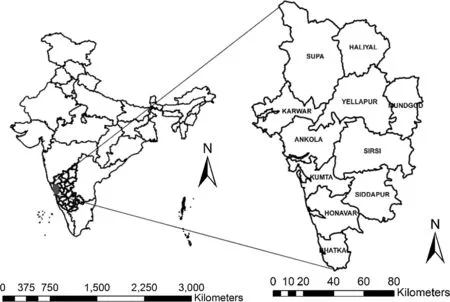
Fig.1 Study area:Uttara Kannada district(Ashwath et al.2012)

Table 1 Distribution of study plots across forest types and villages
Provisional services:Services such as timber and fuelwood collection are under the regulation of the forest department and are collected and sold,as well as used by local communities.The approach adopted for quanti fication of provisional services was firstly through inventory of different tree species in the plots and their characteristics,and secondly,through a collection of secondary data on the end use of different species,be it timber,fuelwood or NTFPs,from the literature and local knowledge.
Carbon regulatory services:In a forest ecosystem,there are five carbon pools,namely:aboveground biomass,belowground biomass,dead wood,litter,and soil carbon.Ideally,all five pools would be estimated.However,due to limitations of time,the aboveground biomass was calculated based on measurements,the belowground biomass estimated using a default,and soil organic was carbon measured and quanti fied.Aboveground biomass was estimated using height and DBH data by calculating the basal area(m2/ha)and converting it to biomass following Murali et al.(2005),since species-speci fic allometric equations are not available for a majority of the species found in the study region.

Based on estimates of aboveground biomass stocks and the use of a default conversion factor of 0.26(Ravindranath et al.1997),belowground biomass was estimated.This was converted to carbon using a default factor of 0.45.Soil samples were collected at a depth of 30 cm from the corners of the 10×10 m plots laid out for shrub enumeration in different forest types,and the composite sample analysed for soil organic carbon.The Walkley–Black method determines soil organic carbon(SOC)by oxidizing carbon with acidic dichromate(Cr2O72-)(Mylavarapu 2014;Walkley and Black 1934).
Assessment of community dependence

Fig.2 Plot layout for assessment of biodiversity in Uttara Kannada district of India

Table 2 Ecosystem services and bene fits obtained(Penman et al.2003)
Forests provide a range of products and services to local communities,the national economy and to international trade.These include timber and non-timber forest products(NTFPs).Ravindranath et al.(1997),Murthy et al.(2005)and Bhat et al.(2003)have assessed the dependence of communities and industries on the forests of Uttara Kannada.In this study as well,an assessment of the dependence of communities on forests was carried out in the nine villages spanning 457 households,close to the ecological plots in evergreen,moist deciduous and dry deciduous forests during 2014.
All these villages are located within 2–3 km from the forest plots.A questionnaire survey collected information on:(1)diversity of NTFPs extracted,parts of the tree used,their end use as well as the season of collection;and,(2)quantity of NTFPs gathered per typical trip and quantity collected in a season.The selected villages and number of households sampled in each village is presented in Table 3.Attempts were made to cover all the households with 100%sampling,however,not all households could be surveyed due to unavailability of some of the members.Speci fic survey-based case studies on two commercially important NTFPs—Garciniaand honey,were also conducted and the findings are discussed in the following section.
Results and discussion
Assessment of biodiversity
Species richness is the number of different species represented in an ecological community,landscape or region(Nolan and Callahan 2006).Table 4 presents the number of species and the number of individuals representing each of the species in the study location across evergreen,moist and dry deciduous forest types.
Evergreen forest type:The number of tree species varied between 54 in Ekkambi to 79 in Tattikai and on average,these evergreen plots had 1978 individuals.In the same plots,the number of shrub species in the sampled area(1000 sq.m)ranged between 23–32 and averaging around 27 species).Enumeration of herbs in 10 replicates of 1 m×1 m plots within the shrub plots nested in the tree plots indicated herb species richness of 24–31.
Moist deciduous forest type:The number of species was highest in Togralli(75),followed by Panchavati(61)and Hudelakoppa(55).Shrub species richness varied between 17–28 and the herb species richness 25–30 in the same plots.
Dry deciduous forest type:The Malgi plot had twice the number of tree species compared to Adikehosur.However,the number of shrubs was higher in Adikehosur.Herb species richness was 17 and 21 in Adikehosur and Malgi,respectively.
Species diversity
Table 5 presents the Shannon–Wiener diversity index of trees,shrubs and herbs across the various plots of the three forest types.The index increases as both the richness and the evenness of the community increase.Typically,values are between 1.5 and 3.5 in most ecological studies,and theindex is rarely greater than four(Diaz et al.2005).Among the tree plots,the Tattikai evergreen plot exhibits the highest diversity while the Adikehosur,dry deciduous plot re flects the lowest diversity.In the shrub plots,the diversity recorded is higher than 2.0 in all plots including Malgi,where the diversity index is as high as 4.51.In the herb plots,the diversity index ranges from 3.08 in Panchavati—a moist deciduous plot,to 2.46 in Adikehosur,a dry deciduous plot.On average,the diversity index of tree species in the evergreen forest is 3.02,followed by the moist deciduous plots with an average Shannon–Wiener diversity index of 2.98,and then the dry deciduous plots with 1.56.The average shrub diversity is highest in the dry deciduous plots(3.46),followed by the moist(2.98)and then the evergreen plots(2.35).The average herb diversity is however highest in the moist deciduous plots,followed by the evergreen and dry deciduous plots.
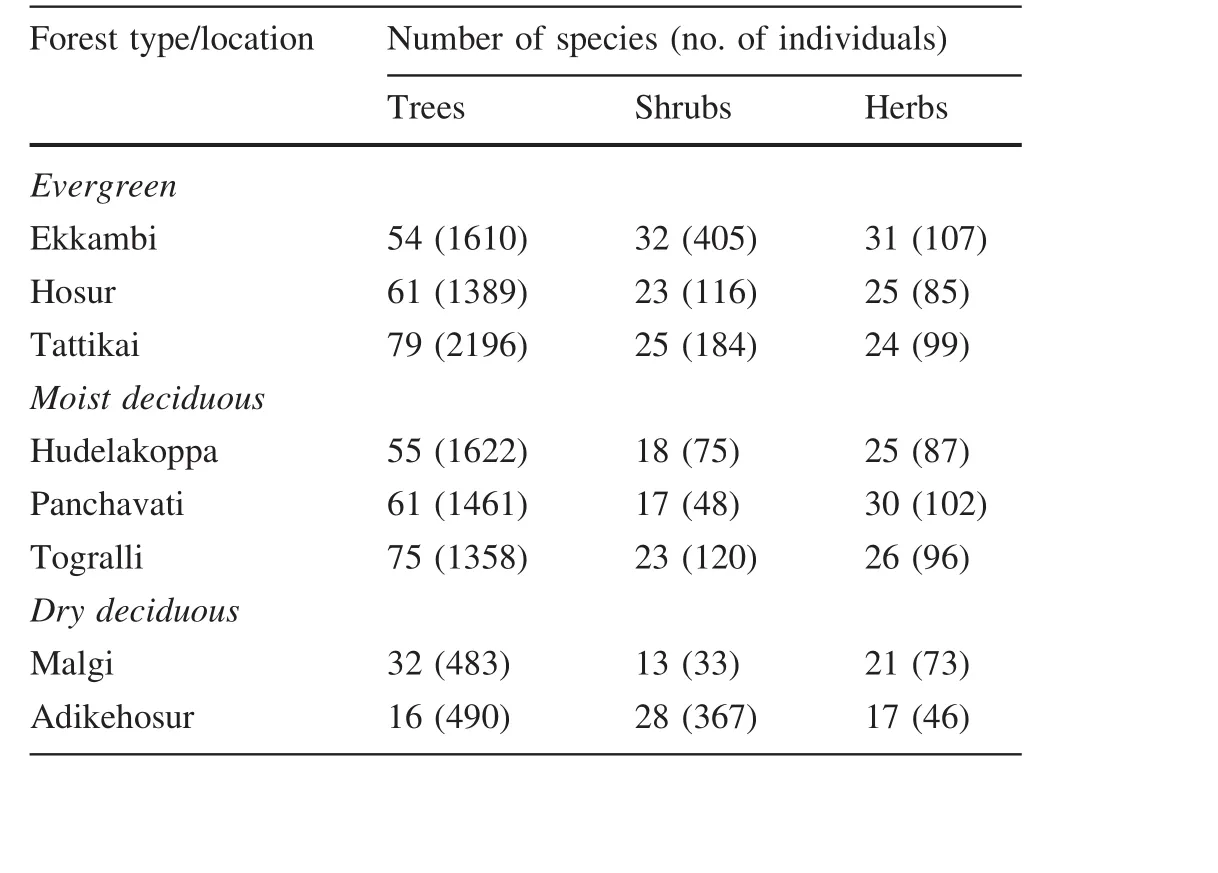
Table 4 Species richness and number of individuals per hectare in different forest type locations
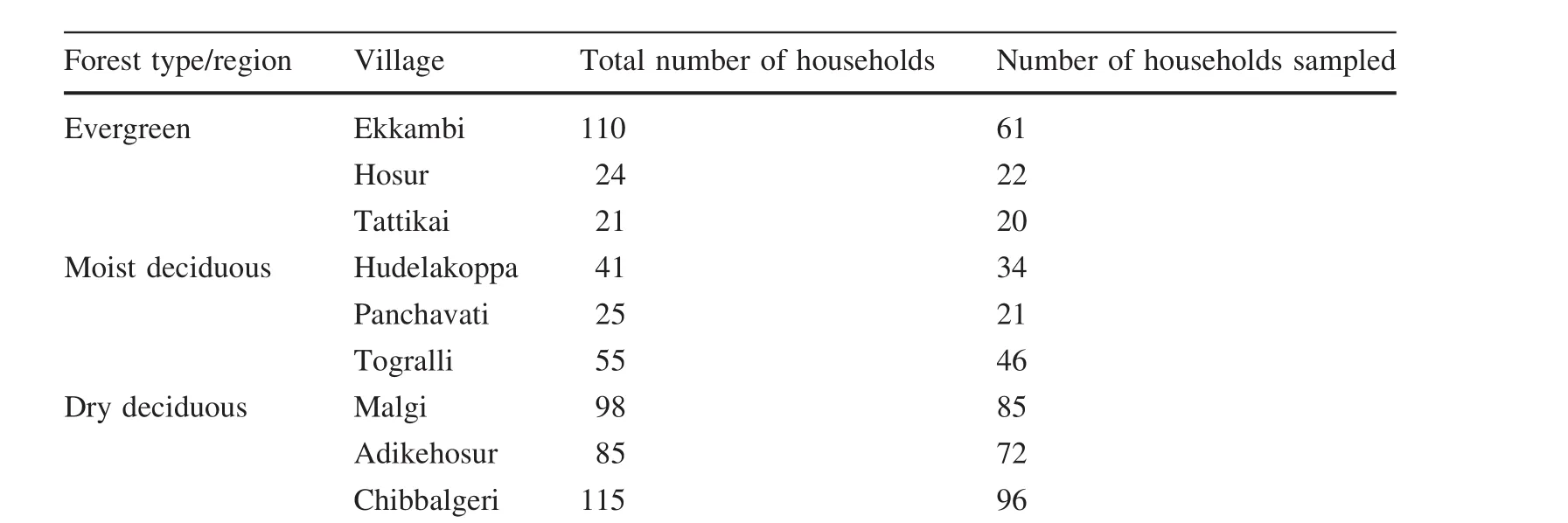
Table 3 Total number of households and number sampled in study villages
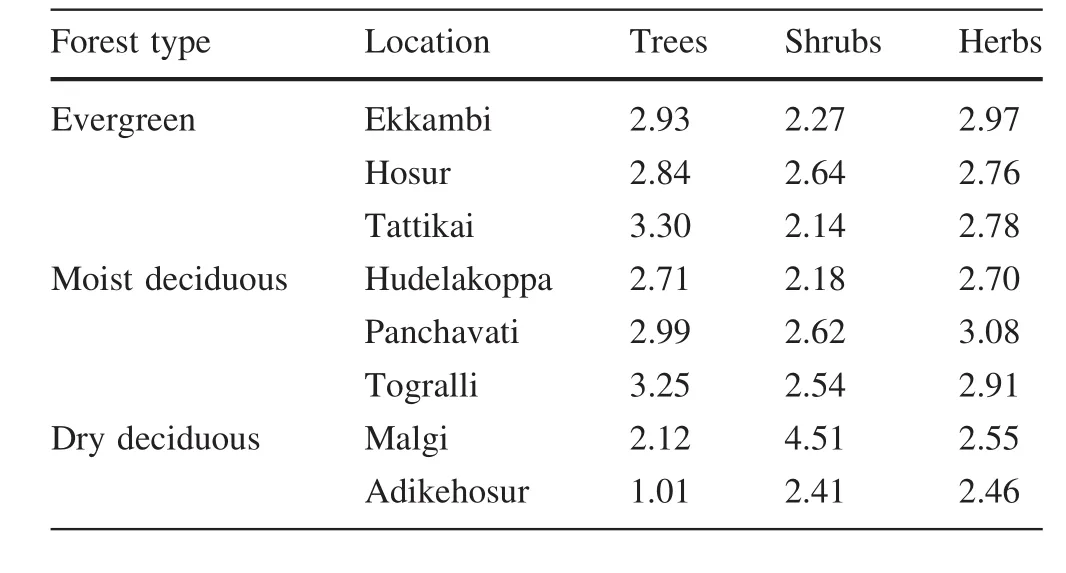
Table 5 Shannon Wiener diversity index of trees,shrubs and herbs in the study locations
Basal area of trees
Basal area is an indicator of growing stock and biomass production.Figure 3 shows the basal area of the plots in the evergreen,moist and dry deciduous forest types.The basal area of the evergreen plots is comparatively higher than that of the moist deciduous and the dry deciduous plots.The average basal area recorded is higher for evergreen plots(39.5 m2/ha)followed closely by the moist deciduous plots(35.9 m2/ha).The average basal area of the dry deciduous plots is lowest at 26.9 m2/ha.Lower basal areas result from a lower amount of precipitation,species composition,age of the trees,disturbance and succession stage of the stand and overall productivity of the ecosystem.Differences in basal area relate to both the density of individuals and their size.
It is evident from the information presented in this section that the forests of the Uttara Kannada district of the Western Ghats are rich in plant biodiversity and have accumulated substantial basal area,an indication of plant growth and biomass availability—both timber and fuelwood to local communities.
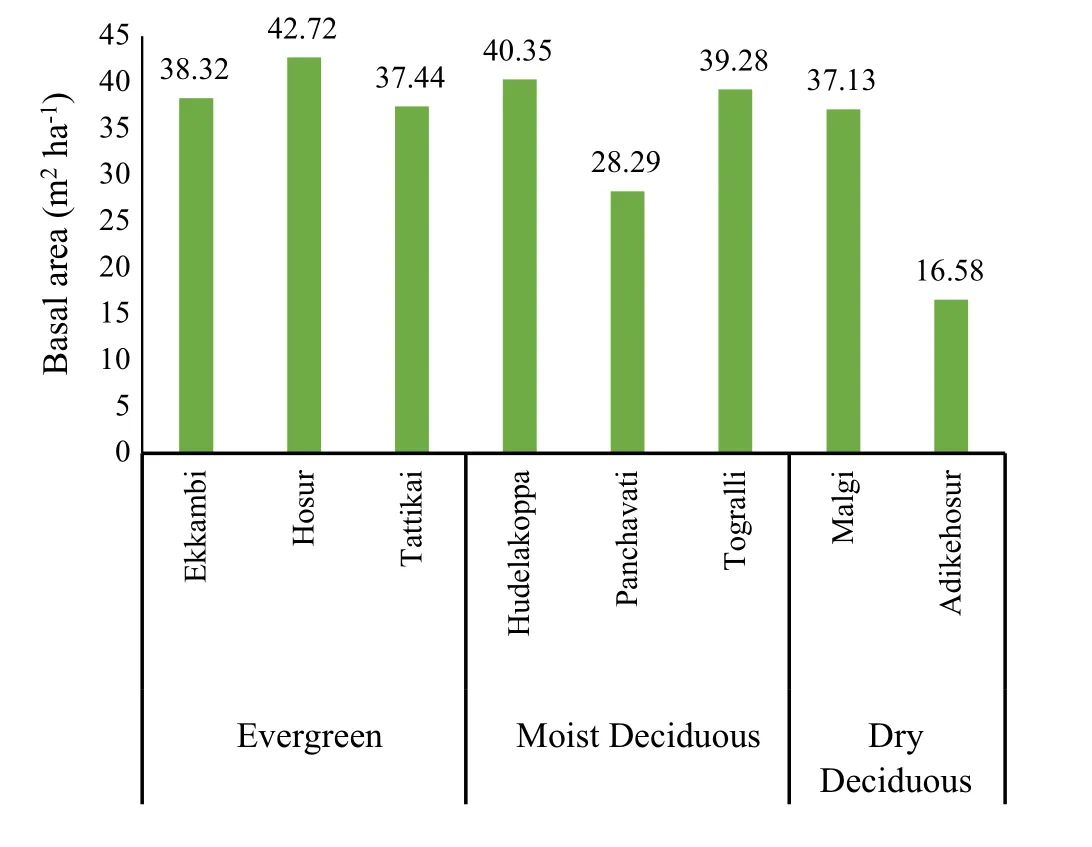
Fig.3 Basal area of trees in study plots of different forest types
Assessment and quanti fication of ecosystem services(provisional and regulating services)
Biodiversity has the potential to in fluence the rate,magnitude,and direction of ecosystem processes(Costanza et al.1997).This section focuses on the effects of biodiversity on ecosystem processes and services that bene fit humans directly or indirectly(Daily 1997).They contribute to making human life both possible and worth living(Okafor et al.1994;Murali et al.2005).Biodiversity affects numerous ecosystem services;some confer direct bene fits on humanity by the provision of goods and raw materials like fuelwood,timber,fruits, fibre and other NTFPs.Indirect bene fits include regulating hydrology and water flow,carbon stocks,pollination,amongst others.
The services quanti fied in this study include provisional and carbon-regulating services from forest ecosystems.Provisional services encompass a diversity of products extracted and utilized by local communities for self-consumption as well as for commercial purposes—local,regional or national markets.The regulating service of climate mitigation through carbon sequestration is through aboveground and belowground biomass,and soil organic carbon.
Provisional services
These are products obtained from forest ecosystems and include food, fibre,fuel,genetic resources,biochemical,natural medicines, pharmaceuticals,and ornamental resources.This study has generated an evidence-base relevant for understanding the signi ficance of many provisional services provided by evergreen,moist and dry deciduous forest types in the Uttara Kannada district.The various species recorded in the different plots of the different forest types provide multiple bene fits.
1.FoodLocal communities consume many plant parts such as fruits,seeds, flowers and leaves.There is a growing awareness of the contribution of NTFPs to household economies,food security and national economy and to conservation of biodiversity.NTFPs provide food,fuelwood,medicines, fibre and cash income to rural households(Spore 2006).In developing countries,80%of people use forest products for food and personal care(Verma et al.2014).In the study area,the communities use several tree species as food or food substitutes.Table 5 presents the total number of tree species yielding food products across the three forest types.
Table 6 shows that around 40,32 and 8 tree species are used for food in the evergreen,moist and dry deciduous forest types,respectively.In the evergreen forests,the number of species providing food ranges from 14 to 38,while the range for the moist and dry deciduous forests varies between 17–22 and 2–17 species,respectively.
Some of the dominant species that are speci fically used in this region as food,food substitutes and flavouring agents include:Curry leaf tree(Murraya koenigii),Goa/Kokam butter tree(Garcinia indica),Malabar tamarind(Garcinia cambogea),Monkey Jack(Artocarpus lakoocha),Bengal currant(Carissa carandas),Jack fruit(Artocarpus integrifolia),Malabar plum(Eugenia jambolana),Mountain Sweet Thorn(Flacourtia montana),and Wild JujubeZiziphus rugosa.Table 7 shows that the number of tree species yielding food is higher in evergreen and moist deciduous forest types compared to the dry deciduous forest type.
2.TimberForests are the prime source of timber in the study area.This includes wood for making furniture,agricultural implements,fencing poles,wooden planks,and rafters for roofs.Forest Working Plans regulate the logging in the forests,and timber is one of the most readily marketable bene fits.Following the National Forest Policy of 1988,forests in India are not speci fically managed with the goal of timber production,although it is important to recognize that the economic value of timber production can be quite signi ficant.Verma et al.(2014)reported the average value of timber from different forest types of India to be around 61,438 Rs ha-1a-1.Hence,it is important to quantify the timber yield in the selected plots of the three forest types studied.
Table 6 and 7 list the number of timber-yielding species.About 27,21 and 9 species are in use for timber purposes across locations in the evergreen,moist deciduous and dry deciduous forest types.The important timber species include Teak(Tectona grandis),Flowering Murdah(Terminalia paniculata),Rosewood (Dalbergiaspp.)and Ironwood(Cordiaspp.)Table 8 presents the quantity of timber in these plots computed by considering only trees with a girth>50 cm.
In the evergreen forest types,the quantity of timber available ranges from 155 tonnes/ha in Tattikai to 166 tonnes/ha in Ekkambi(Table 8).In the moist deciduous plots,Hudelakoppa has the highest timber quantity at 217 tonnes/ha followed by Togralli with 191 tonnes/ha and Panchavati with 144 tonnes/ha.The two dry deciduous plots at Adikehosur and Malgi record approximately 120 and 208 tonnes/ha of timber,respectively.Among the three forest types,the moist deciduous forests record the highest amount of timber(217 tonnes/ha),followed by the dry deciduous(208 tonnes/ha)and the evergreen forests(166 tonnes/ha).
3.FuelwoodFuelwood is the main source of energy to the rural population for cooking along with other household and non-agricultural uses.National Sample Survey Organisation(NSSO 1998)reveals that forests meet more than half of the fuelwood requirements of the country.Local communities gather fuelwood irrespective of species,although there are preferences for some over others.Local people collect fallen wood for cooking food and heating.Wood is the most important(Handa 1998)product in the Western Ghats as it is used for processing areca palm nuts,cardamom,cashew and other agricultural products including rice.

Table 6 Number of species providing provisional ecosystem services in the three forest types

Table 7 Number of species providing provisional services according to different forest types

Table 8 Quantity of structural timber and poles available for extraction in the three forest types
This study reports that twigs and branches of all tree species are use as fuelwood.
The quantity of wood available as fuelwood was calculated,considering the total biomass stock in the various plots excluding the quantity estimated as timber.Table 9 presents fuelwood quantities available in the various plots.The quantity of fuelwood available for extraction in the evergreen forest type ranges from 134 to 164 tonnes/ha,while in the moist deciduous forests,it is 91–116 tonnes/ha,and in the dry deciduous forests,80–85 tonnes/ha.The average quantity of fuelwood available for extraction is highest in the evergreen forest(146 tonnes/ha),followed by the moist deciduous(101 tonnes/ha)and the dry deciduous forest type(83 tonnes/ha).
4.FodderCollection of tree leaves and grasses from the forest is a regular activity to feed livestock as well as to spread out on the floor in cattle sheds.There were six tree species used for fodder in the evergreen forest type,while in the moist and dry deciduous forests the number of species used for the same purpose was five.Fodder-yielding species included Beechwood(Gmelina arboreaRoxb.),Dhaman(Grewia tilifoliaVahl.),Crepe Myrtle(Lagerstomia parvifolia),Ceylon Oak(Schleichera trijuga),andDog Teak(Dillenia pentagyna).Although these species are documented as fodder species,local communities use branches and tops of many other species as well.
5.Medicinal purposesApproximately 1500 species of vascular plants are used for medicinal proposes bytribal and ethnic groups in India(Ayyanar and Ignacimuthu 2005).The preservation of traditional plant knowledge as a part of the global heritage has been championed by several authors(Lambert et al.1997;Pearce and Pearce 2001)as well as recognized by the Convention on Biological Diversity(CBD)in 2001(Ghosh 2003).In the developing world,traditional medicinal uses of plants are often the only or primary healthcare available to people and extremely important in some locations(Ghosh 2003).The number of species used for medicinal purposes ranged from 91 in the evergreen forest type to 30 in the dry deciduous forest type(Table 6).Table 7 indicates that the forests of the Western Ghats are home to several species used for medicinal purposes.Some examples of species include Pisa(Actinodaphne hookeriMeisn),Ukshi(Calycopteris floribunda(Roxb.)Lam.Ex Poir.),Ash Sheora(Glycosmis pentaphylla),Raktamara(Knema attenuate),Mappia(Nothapodytes nimmionana),Wild Nutmeg (Myristicabeddomei),Cinnamon(Cinnamomum zeylanicum),Indian Gooseberry(Emblica of ficinalis),Bedda nut tree(Terminalia bellerica),and Myrobalan(Terminalia chebula).
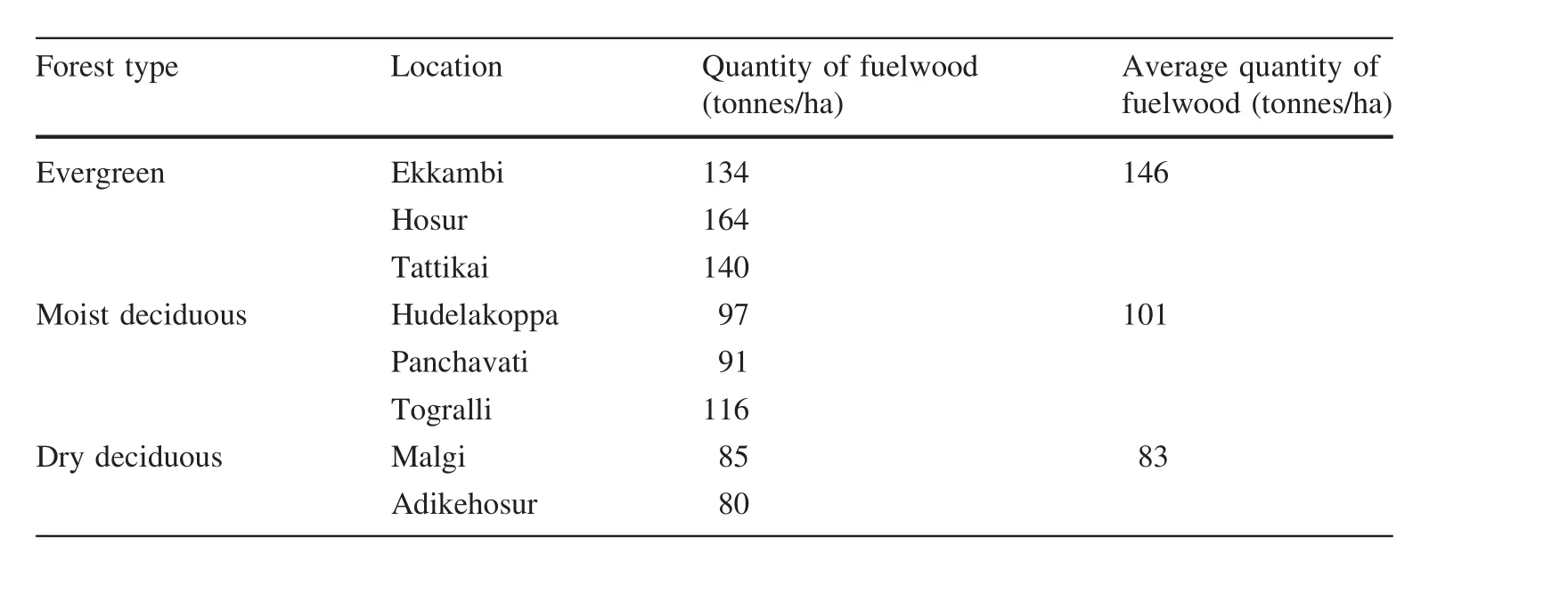
Table 9 Quantity of fuelwood available for extraction in the study locations
6.ManureThe important green manure-yielding species include Slow Match Tree(Careya arborea),Ukshi(Calycopteris floribunda),Bedda nut tree(Terminalia bellerica),Myrobalan (Terminalia chebula),Vetti(Aporosa lindleyana),Macarange(Macaranga peltata),Jungle geranium(Ixora brachiate)andcommon Indian linden(Grewia tilifolia).
7.Fibre and other usesSpecies providing fibre include common Indian linden(Grewia tilifolia),Kapok Tree(Ceiba pentandra)and Black varnish tree(Holigarna arnotiana).The number of these species in the study plots is nil or one,and are also used for other purposes such as the extraction of dyes,essential oils,as larvicide and insecticide,for ornamental purposes,food for larvae,and in sericulture and as a fish poison.The extract of English Clove(Eugeniacaryophyllata).is used for termite resistance,the fruit extract of Beechwood(Gmelina arborea)as a polishing fluid,Sapindusspp,also known as the soapnut tree,is used commercially for the preparation of soaps and other cosmetic products.
As a part of the study of dependency by the communities on forest resources,a case study on one of the commercially as well as domestically important tree species,Kokam(Garciniaspp.)was carried out.Box 1 presents the details of this study.
Regulatory services
Regulatory services are the indirect bene fits provided by facilitating the regulation of various physio-chemical and climatic processes.These ecosystem processes include air quality maintenance,climate regulation,water regulation,erosion control,water puri fication and waste treatment,regulation of human diseases,biological control,pollination and storm protection.These regulating services are very critical;however,due to limitations of time and resources,an estimation of water and soil-related services was not conducted.
Carbon regulation is an important service from forest ecosystems.Forests constitute one of the world’s major carbon sinks;contain about 80%of the aboveground terrestrial biospheric carbon and 40%of the belowground carbon.Forests play an important role in the global carbon cycle.
According to MoEFCC(2012),based on empirical evidence from across the country,the net increment in carbon stocks of forests was approximately 217 million tonnes between 1994 and 2004.In terms of absolute estimates,the carbon stocks of Indian forests were approximately 6289 million tonnes of carbon in 2004.
1.Biomass carbonEstimates of the carbon regulatory services,for the three distinct forest types(Table 11),show that the biomass carbon(aboveground+belowground)in the dry deciduous forests(140 tonnes/ha)was lowest compared to the moist deciduous(162 tonnes/ha)and evergreen forest types(175 tonnes/ha).Within the evergreen forests,the carbon biomass ranges from 167 tonnes/ha in Tattikai to 187 tonnes/ha in Hosur.In the moist deciduous plots,the range is large with a high of 178 tonnes/ha in Hudelakoppa to alow of 133 tonnes/ha in Panchavati.Between the two dry deciduous plots there was a marked difference in carbon stocking,with Malgi recording 166 tonnes/ha and Adikehosur only 113 tonnes/ha.

Table 10 Extraction and use of Garcinia
2.Soil carbonForest soil organic carbon is an important component of the global carbon cycle and the changes in its accumulation and loss directly affect the terrestrial ecosystem carbon storage and the global carbon balance.This study estimates the soil organic carbon using the Walkley–Black method(Table 11).Soil organic carbon in the moist deciduous plots is highest at 59±13.7 t C/ha,followed by the evergreen(54±14.9 t C/ha) and the dry deciduous(42±18.6 t C/ha)forests.

Box 1 Garcinia case study

Table 11 Biomass(aboveground+belowground)and soil carbon across forest types
Assessment and quanti fication of community dependence on forests
In all the forest zones,there is extraction of a diversity of NTFPs.Table 12 gives percentage dependence of households on NTFPs for fuelwood,fodder and manure in the three forest zones.
1.FuelwoodThe level of dependence on forests for fuelwood is signi ficant in all villages across the three forest zones.In the evergreen forests,dependence ranges from 89 to 100%,while for the moist deciduous forests,dependencerangesfrom72to100%,98to100%in the dry deciduous zone(Table 12).This dependence can be better understood by analysing the quantity of fuelwood collected;average quantity of fuelwood gathered in all the villages was found to be around 2 tonnes.Villages near the evergreen forests,such as Hosur,gathered close to 3 tonnes of fuelwood annually while villagers in Tattikai gather about 1.9 tonnes.Villages close to the dry deciduous and moist deciduous forests gather about the same quantity of fuelwood on average,althoughthereareslightvariationsinquantities across villages and households(Table 13).
2.ManureExtraction of manure in the form of green and dry leaves and its application for cattle bedding as well as mulching purposes is widely practised by farmers in allthethreeforestzones.In fiveoutofninevillages,over 40%of the households practiced collection of green leaves and in six out of nine villages,over 20%(up to 75%)collected dry leaves(Table 12).Thus,there is a large dependence of many households on forests for manure in the Western Ghats.Villages in the evergreen forest zone gather the highest amount of green leaves,about 4 tonnes on average per household.The next highest quantity is gathered in villages near the dry deciduous forests(2.7 tonnes/household),followed by those close to the moist deciduous forests(1.7 tonnes/household)for manure(Table 13).The quantity of dryleavesextractedandusedasmanureisalsohighestin the evergreen forest villages(2.6 tonnes/household).The quantity of dry leaves gathered ranged between 1.4 tonnes/household/year and 3.5 tonnes/household/year.
3.FodderRural households normally graze cattle in forests,wastelands and croplands while the practice of stall-feeding is limited.Given this,collection of grasses for fodder is common in only two of the three villages in the evergreen forest zone and in one of the dry deciduous villages(Table 12).The percentage of households depending on forests for green grass was found to be 34 and 24%in Tattikai and Ekkambi respectively.Similarly,the level of dependence on dry grass in the same villages was found to be 20 and 15%.Local communities graze their livestock in forest and non-forest areas and the harvest of green leaves from forests for fodder purposes is limited.The quantity gathered across the two villages is about 2.4 tonnes/household of dry grass and about 3.2 tonnes/household of green grass(Table 13).
4.NTFPsIn the study villages,a large diversity of NTFPs is collected for food and medicinal purposes.The percent of household’s dependant on NTFPs is varied and high on commercially important species such as Cempedak(Artocarpus integrifoliaLinn.F.),Malabar Tamarind(Garcinia cambogiaL.)and Mango(Mangifera indicaL.)(Table 14).However,a large proportion of non-timber forest products is used for subsistence only in a few of the households.
Conclusions
One of the main objectives of this study was to assess the status of biodiversity in the region,aimed at presenting an evidence base of ecosystems providing multiple services.In the sampling sites,the number of tree species ranged from 16 to 79/hectare depending on the forest type,with the lowest in the dry deciduous and highest in the evergreen forests.The study estimates a Shannon–Wiener index of 3.02 in the evergreen forest type,followed by 2.9 for the moist deciduous plots and 1.54 for the dry deciduous plots.The values for tree diversity range from aminimum of 1.01 in the dry deciduous forests to a maximum of 3.30 in the evergreen forests.In the dry deciduous forests,the diversity value of herbs was found to be above two while shrubs diversity values reached a rare 4.51 as it indicates a very high level of richness and evenness of the community increase(refer ‘‘Materials and methods’’section).These numbers themselves re flect the quantity and quality of biodiversity richness in the region.This not only mirrors the health of the ecosystems but also represents the vast potential in these forests with respect to the provision of multiple ecosystem services.Another important objective of this research was to highlight the flow of ecosystem services from selected forest types and the dependency of communities on these services.This study presents this flow in the form of provisional services used by the communities,such as food,timber,fuelwood,fodder,medicinal, fibre and other miscellaneous uses.The diversity in ecosystem services highlights the signi ficance of the forests as a source of provisional services.Stakeholder surveys revealed that one of the widely used resources from forests was fuelwood.The forest stocks of fuelwood ranged from 83 tonnes in the dry deciduous forests to 146 tonnes in the evergreen forests with the dependency of communities ranging from 72 to 100%in all three forest types.The consumption rates of fuelwood range from 1.9 tonnes in dry deciduous forest villages to approximately three tonnes in evergreen forest villages.The high level of dependency on this resource re flects the contribution of the forests in providing energy supplies to the communities.Apart from fuelwood,the dependency of communities for the forests for manure and fodder is also signi ficant,mainly from the evergreen and moist deciduous forest types.The dependency on other NTFPs from mainly commercially important species is high from these forests.Results show that forty tree species are used for food or as food substitutes from the evergreen forest type alone.Twenty-seven species are timber resources,while trees for medicinal purposes constitute over ninety species.Forests contribute signi ficantly to subsistence resources that help secure the livelihoods of rural communities living in their vicinity.One of the main outcomes of this study is the demonstration of the importance of non-monetary bene fits of forest ecosystems,although the true contribution of these services may be appreciated by valuing them in economic terms.

Table 12 Percentage households collecting NTFPs for fuelwood,manure and fodder purposes
Bene fits provided by the ecosystem services are direct and easy to quantify;however,one of the most important regulatory services offered by forests,‘carbon sequestration’can be directly linked to bene fits not only at a local scale but to a global scale.The total biomass stocks in the forest types of the study region ranged from 189 t C/ha for dry deciduous forests to 221 and 229 t C/ha for the moist deciduous and evergreen forests,respectively.
In conclusion,a key contribution of this study is the quanti fication ofbiodiversity and someofthekey ecosystem services based on permanent plots and the quanti fication of these services based on the primary survey of various stakeholders.The results indicate that forest ecosystems underpin the well-being of the population dependent directly and indirectly on them.Thus,conservation and sustainable use of services provided by forest ecosystems can help to provide livelihood security to local communities and the global bene fit of carbon regulation.Reasons for the degradation of valuable ecosystems can be complex and varied,including incomplete information and non-recognition of values of the Western Ghats ecosystems.Not recognizing the policy and institutional triggers of the stress can in fluence the human well-being with different impacts on various groups.This clearly justi fies the need to recognize,demonstrate and capture the ecological values and internalize them in the decision-making.A comprehensive evaluation ofthe ecosystem services enables visualization of the tradeoffs that different groups of people face clearly,in addition to guiding efficient resource allocations,providing a hint at future uncertainties in resource availability,designing biodiversity conservation programs,and highlight the distortions from nonrecognition of values from ecosystem services.
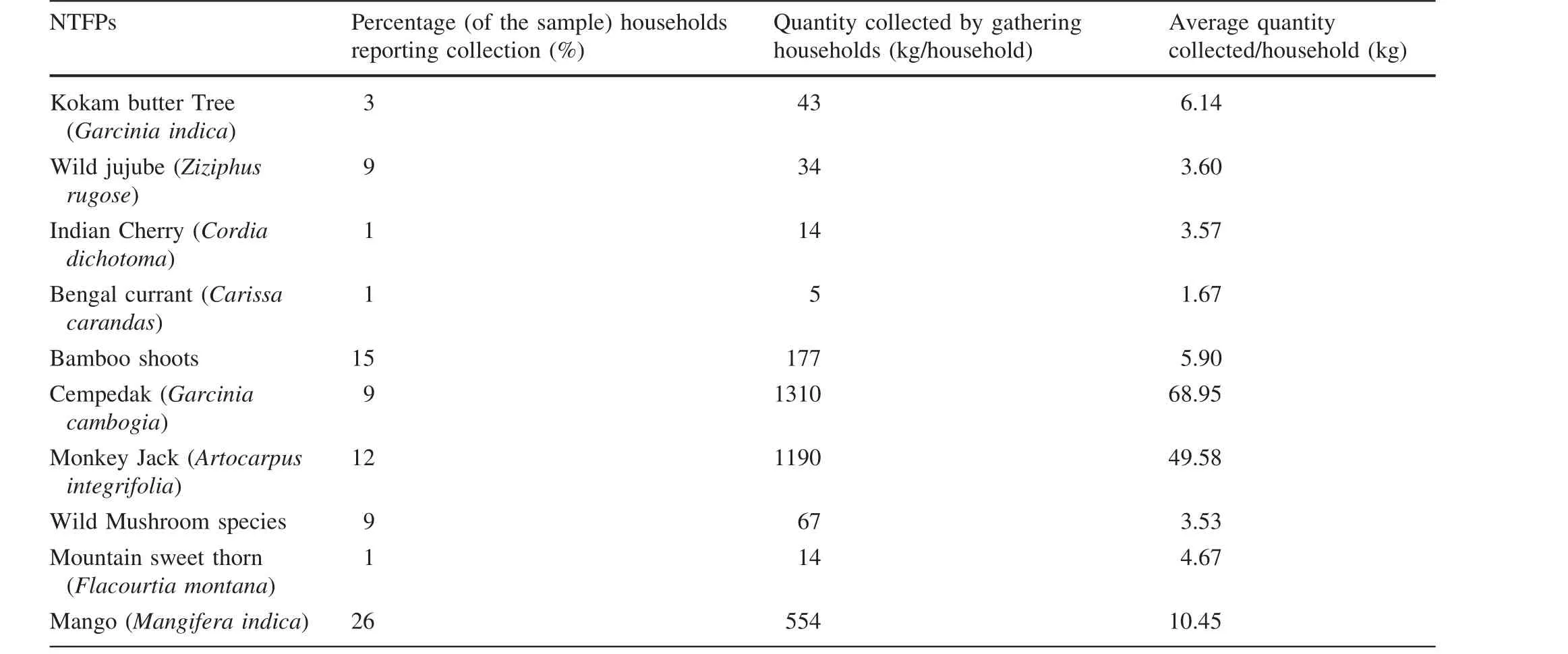
Table 14 Quantity of NTFPs collected and percentage households’dependent on NTFPs
AcknowledgementsThe authors would like to acknowledge The TEEB India initiative of MoEFCC under which the current study was conducted for the‘The Economics of Ecosystem Services and Biodiversity in Western Ghats Forest Ecosystems,India’pilot project.The contribution by Gesellschaft fu¨r Internationale Zusammenarbeit(GIZ)for coordinating the project is appreciated.The hard work of the research and field scientists at the Centre for Sustainable Technologies,Indian Institute of Science is valued.Acknowledgement is also due to Pondicherry University.
References
Ashwath DN,Subash CMD,Ramachandra TV(2012)Ecosystem goods and services in Uttara Kannada.In:Wetland resources and livelihood,national conference on conservation and management of wetland ecosystems.http://wgbis.ces.iisc.ernet.in/energy/lake2012/fullpaper/ashwath_fullpaper.pdf
Ayyanar M,Ignacimuthu S(2005)Traditional knowledge of Kani tribals in Kouthalai of Tirunelveli hills,Tamil Nadu,India.J Ethnopharmacol 102:246–255
Bhat PR,Murali KS,Hegde GT,Shastri CM,Bhat DM,Murthy IK,Ravindranath NH(2003)Annual variation in non-timber forest product yield in the Western Ghats,Karnataka,India,2003.Curr Sci 85(9):1350–1355
Champion SH,Seth SK(1968)A revised survey of the forest types of India.Millennium ecosystem assessment(MEA),2005.Ecosystems and human well-being:synthesis.Island Press,Washington
Costanza R,D’Arge R,De Groot RS,Farber S,Grasso M,Hannon B,Limburg K,Naeem S,O’Neill RV,Paruelo J,Raskin RG,Sutton P,Van den Belt M(1997)The value of the world’s ecosystem services and natural capital.Nature 387(6630):253–260
Daily G(1997)Introduction:what are ecosystem services?In:Daily G (ed)Nature‘s services:societal dependence on natural ecosystems.Island Press,Washington
Delgado LE,Sepu′lveda MB,Mar?′n VH(2013)Provision of ecosystem services by the Ayse′n watershed,Chilean Patagonia,to rural households.Ecosyst Serv 5:102–109
Dhyani S,Dhyani D(2016)Signi ficance of provisioning ecosystem services from moist temperate forest ecosystems:lessons from upper Kedarnath valley,Garhwal,India.Energy Ecol Environ 1(2):109–121
Diaz S,Tilman D,Fargione J,Chapin III FS,Dirzo R,Ktzberber T(2005)Biodiversity regulation of ecosystem services.Trends Cond 279–329
FAO(2014)State of the world‘s forests:enhancing the socioeconomic bene fits from forests.Food and Agriculture Organization of the United Nations,Rome
Ghosh A(2003)Herbal folk remedies of Bankura and Medinipur districts,West Bengal(India).Indian J Tradit Knowl 2:393–396
Handa SS(1998)Indian efforts on standardization and quality control of medicinal plants using scienti fic parameters.Amruth(Tradit Healthc Mag)2(10)
Hooper DU,Chapin FS III,Ewel JJ,Hector A,Inchausti P,Lavorel S,Lawton JH,Lodge D,Loreau M,Naeem S,Schmid B,Seta¨la¨H,Symstad AJ,Vandermeer J,Wardle DA(2005)Effects of biodiversity on ecosystem functioning:a consensus of current knowledge.Ecol Monogr 75:3–35
Lambert J,Srivastava J,Vietmeyer N(1997)Medicinal plants:rescuing a global heritage.Agriculture and forestry systems.World Bank,Washington
Magurran AE(2013)Measuring biological diversity.Wiley,New York
MoEFCC(2012)India second national communication to the United Nations framework convention on climate change,Ministry of Environment and Forests,Government of India
MoEFCC,GIZ(2014)The economics of ecosystems and biodiversity TEEB India initiative:interim report—working document
Murali KS,Bhat DM,Ravindranath NH(2005)Biomass estimation equation for tropical deciduous and evergreen forests.Int J Agric Resour Gov Ecol 4:81–92
Murthy IK,Bhat PR,Ravindranath NH,Sukumar R(2005)Financial valuation of non-timber forest product flows in Uttara Kannada district,Western Ghats,Karnataka.Curr Sci 88:1573–1579
Myers N,Mittermeier RA,Da Fonseca GAB,Kent J(2000)Biodiversity hotspots for conservation priorities.Nature 403:853–857
Mylavarapu R(2014)Walkley–Black method.Soil test methods from the Southeastern United States,p 158
Nasi R,Frost PGH(2009)Sustainable forest management in the tropics:is everything in order but the patient still dying?Ecol Soc 14(2):40
National Sample Survey Organisation(NSSO)(1998)Report no.452:common property resources in India,NSS 54th round
Nolan KA,Callahan JE(2006)Beachcomber biology:the Shannon–Wiener species diversity index.In:Proceedings of workshop ABLE,vol 27
Okafor JC,Moradion FI,Amaja(1994)Non-timber forest products(Nigeria):consultancy paper prepared by the tropical forest actions programme(TFAP)forest management,evaluation and co-ordination units(FORMECU)and Federal Department of Forestry(FDF)Abuja,Nigeria,p 8
Patricia B,P fisterer AB,Buchmann N,He JS,Nakashizuka T,Raffaelli D,Schmid B(2006)Quantifying the evidence for biodiversity effects on ecosystem functioning and services.Ecol Lett 9:1146–1156
Pearce DW,Pearce CG(2001)The value of forest ecosystems
Penman J,Gytarsky M,Hiraishi T,Krug T,Kruger D,Pipatti R,Buendia L,Miwa K,Ngara T,Tanabe K,Wagner F(2003)Good practice guidance for land use,land-use change and forestry.Institute for Global Environmental Strategies,Hayama
Ravindranath NH,Somashekhar B,Gadgil M(1997)Carbon flow in Indian forests.Clim Change 35(3):297–320
Spellerberg IF,Fedor PJ(2003)A tribute to Claude Shannon(1916–2001)and a plea for more rigorous use of species richness,species diversity and the ‘Shannon–Wiener’Index.Glob Ecol Biogeogr 12(3):177–179
Spore CTA(2006)Information for agricultural development in ACP countries
TEEB (2010)The economics of ecosystems and biodiversity ecological and economic foundations.In:Kumar P(eds).Earthscan,London and Washington
Thompson ID,Okabe K,Tylianakis JM,Kumar P,Brockerhoff EG,Schellhorn NA,Parrotta JA,Nasi R(2011)Forest biodiversity and the delivery of ecosystem goods and services:translating science into policy.Bioscience 61(12):972–981
Verma M,Negandhi D,Wahal AK,Kumar R,Kinhal GA,Kumar A(2014)Revision of rates of NPV applicable for different class/category of forests.Indian Institute of Forest Management,Bhopal
Walkley A,Black IA(1934)An examination of the Degtjareff method for determining soil organic matter and a proposed modi fication of the chromic acid titration method.Soil Sci 37:29–38
 Journal of Forestry Research2018年3期
Journal of Forestry Research2018年3期
- Journal of Forestry Research的其它文章
- In vitro propagation of conifers using mature shoots
- ‘Relationships between relationships’in forest stands:intercepts and exponents analyses
- Effects of application date and rate of foliar-applied glyphosate on pine seedlings in Turkey
- Assaying the allelopathic effects of Eucalyptus camaldulensis in a nursery bed incorporated with leaf litter
- Effects of soil compaction on growth variables in Cappadocian maple(Acer cappadocicum)seedlings
- Variation and selection analysis of Pinus koraiensis clones in northeast China
